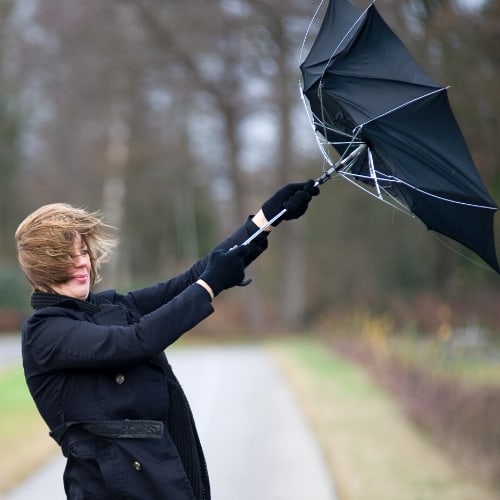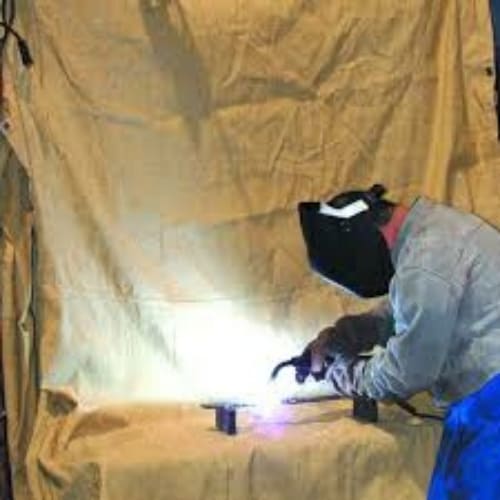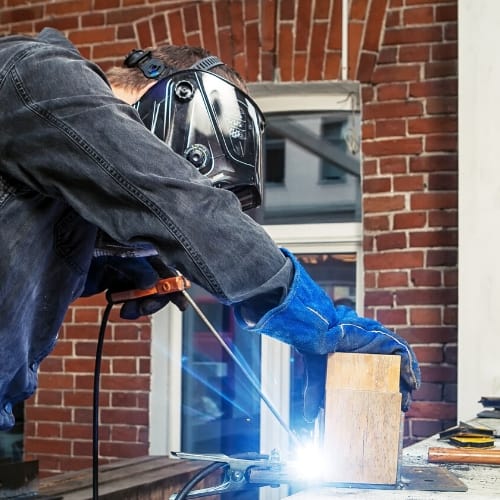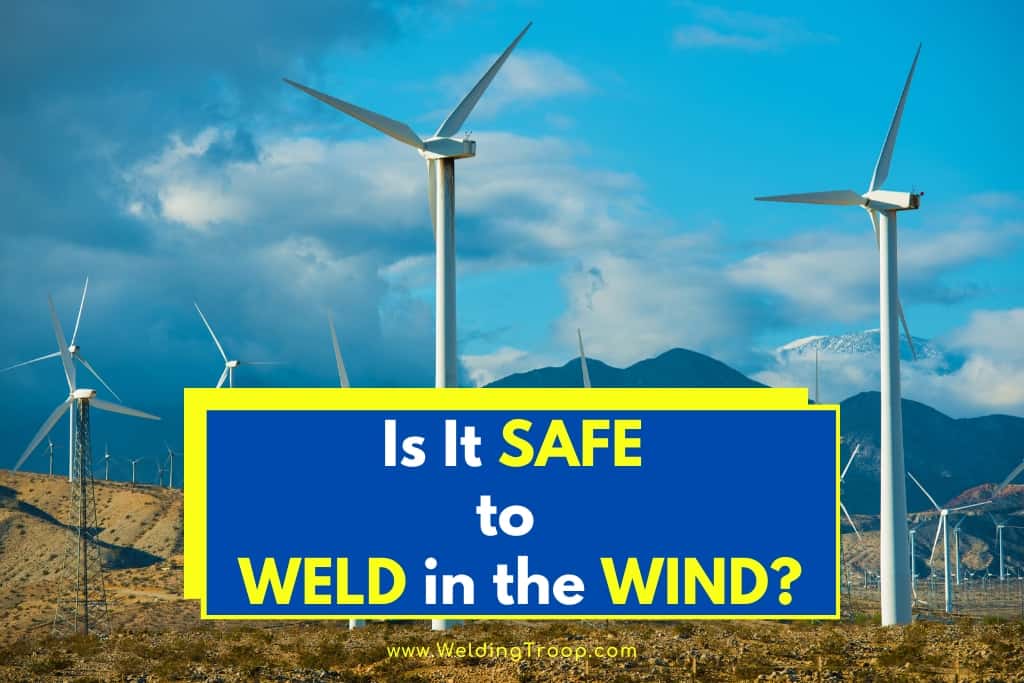You may have welded in harsh conditions, but is it safe to weld in the wind? Working a welder in the wind requires the correct equipment, protection, and a close eye on the weather in case conditions worsen.
Is it safe to weld in the wind? You can safely stick weld and flux-core weld in the wind under 35 mph, but MIG and TIG welding are not practical even in light wind. The inert gases you need for MIG and TIG welding blow away in windy conditions and cannot protect the weld from contaminates.
When working in a windy area, a welder must execute extreme caution. MIG and TIG welding is not valid unless the welding area is completely shielded from the wind. Flux core welding and stick welding are more practical for windy events.
Table of Contents
What Is The Maximum Wind Speed For Welding?
| Options | Welding types | Maximum wind velocity (mph) |
|---|---|---|
| 1 | MIG Welding | 5 |
| 2 | TIG Welding | 5 |
| 3 | Stick Welding (SMAW) | 35 |
| 4 | Flux-core Welding | 35 |
Welding In Windy Conditions
Welding in windy conditions requires caution and the right equipment. Stick welding and flux-core welding are practical for windy conditions, but MIG and TIG welding require shielding from the wind. Welders should avoid winds strong enough to move tools or the welder, and MIG and TIG welders should only work in winds under 5 mph.
Welders can block the wind around the weld area to protect the shielding gas using welding blankets and tents made of fire-retardant fiberglass.
It is possible to wear eyeglasses under a welding helmet, but it might be uncomfortable or inconvenient. Prescription welding helmets or safety glasses might be more suitable.
Do You Need Ventilation When Welding Outside?
Yes, it is recommended to have good ventilation when welding outdoors. Welding in windy conditions can be particularly challenging, as the wind can blow away shielding gases and cause weld spatter to fly in unexpected directions.
Welders should take steps to protect themselves and their work area from the wind, such as using welding blankets or tents to block the wind. Additionally, it’s important to wear appropriate protective gear, including eye and face protection, and clothing that is resistant to heat, sparks, and flames.
Adequate protection against UV and IR radiation is vital when welding, so make sure to wear a tight-fitting, opaque welder’s helmet.
Can You Weld in the Wind?
Welders frequently work in windy conditions. However, if the wind is too severe, welding is not a safe endeavor. Winds that are strong enough to move you or your tools around are not ideal for welding.
If MIG or TIG welders are your only option for welding in windy conditions, you will have to block your shielding gas from the wind.
Experts recommend only welding in winds under five mph if you use a MIG or TIG welder.

Light winds will blow the inert gas away from the weld puddle. If you cannot keep the gas over the pool, porosity can occur. One way to block the inert gas from the wind is to erect a shelter around the welding area.
When you install a shelter around your work area, never use flammable material. Although most camping tents are coated with a flame-retardant coating, welding spatter can melt the tent. The best material to shield the wind and protect you from sparks is a welding blanket.
3 Tips for MIG Welding in Windy Weather >> Check out the video
Welding Blankets
Unlike most tarps and blankets, welding blankets are composed of fire-retardant material. Manufacturers of welding supplies use woven fiberglass in the blankets, and most products will protect against temperatures up to 1000° F.
The blankets include grommets for stringing rope through them, and it’s a good idea to use a fiberglass rope to hang up the blanket. The blanket is heavy enough for use as a windbreak when you’re welding, but try to keep it at least a foot away from the welding gun.

Position the blanket so that it blocks the wind and protects the shielding gas. To make sure that the blanket is doing its job, perform a test weld with the shielding gas. If you can weld without any aberrations or porosity, the gas is not affected by the wind and should work fine.
The blanket is fire-retardant but is not fireproof. It’s intended to protect you and the surrounding area from welding spatter, but it will melt if objects over 1000° F land on it. For strong winds, try using a welding tent to protect your shielding gas.
Welding Tents
Welding tents offer further protection from winds and are composed of fiberglass like the welding blankets. When you cannot protect the shielding gas with a single welding blanket, install a welding tent over your work area.
The tent protects you from spatter and flare-ups and shields your inert gas from the wind. Unlike a welding blanket, the canopy covers all four sides around you and includes a roof. Be sure that the sides and ceiling are at least a foot away from the weld.
Another factor you must consider when using a tent is the fumes emitted from the welding metal. If you’re welding a coated metal like galvanized steel, you must use a respirator.
A welding tent protects you from the wind, but it also makes ventilation more difficult. Wear a premium respirator under your welding helmet to prevent the inhalation of toxic fumes.
Another option you have with MIG and TIG welders is to change your welder from standard wire to flux core.
Flux Core Welding
Unlike standard MIG or TIG electrodes, flux core wire does not require a shielding gas. The flux in the electrode creates a shield around the welding pool and blocks contaminates from entering the weld.
Before purchasing flux core wire, check your machine to make sure it accepts both types of wire.
If you want to convert from MIG or TIG wire to flux core, you’ll have to make a few adjustments on your machine. These adjustments include:
- Remove the standard wire
- Replace the drive roll and insert the flux core wire
- Change the machine’s polarity
Once you’ve made the changes to the machine, you’re ready to weld. Depending on the strength of the wind, you may have to use a welding blanket or tent. The flux protects the weld, but the wind can blow the spatter against you.
Does Wind Affect Stick Welding
With shielded metal arc welding (SMAW) or stick welding, you will not run into the same issues with the wind as you would with MIG or TIG welding. Stick welding rods contain flux that protects the weld from contaminates and does not need shielding gas.
Experts recommend using stick welding for windy occasions and contend that stick welding is practical in winds up to 35 mph.
Although indoor projects are ideal for MIG or TIG welders, SMAW is the welding of choice for outdoor projects.
Arc welding offers several advantages over other forms of welding during windy projects.
- Lower costs
- Less cumbersome
- More versatile
- Easier to use in awkward positions
- Improved electrodes
Lower Costs
Arc welding supplies and equipment are less expensive than MIG or TIG welding. Since the flux is on the wire, you will not have to shell out extra cash for expensive shielding gas.
Less Cumbersome
Working in the wind, especially at high altitudes, is a risky endeavor. With arch welding, you do not have to carry a cumbersome gas tank to effectively weld. You can weld in harsh conditions without having the extra burden of carrying a large tank.

More Versatile
Unlike other types of welding, SMAW is easier to use when you work with different metals. When you have to change metals, you simply replace the electrode on the arc welder. MIG and TIG welding requires you to use another shielding gas when you switch metal types.
Easier in Awkward Positions
If you have to weld above your head, arc welding is ideal. The SMAW electrode is up to 16 inches long and can reach tight joints and deep recesses. MIG and TIG wires are shorter and harder to use in difficult areas.
Improved Electrodes
With MIG and TIG wires, manufacturers are unable to add alloys to enhance the weld’s strength. Arc welding flux is coated with strengthening alloys that produce sturdier welds. Executing a strong weld is especially essential when you’re working in high wind.
Welding in Other Weather Conditions
Although few welders attempt to work in a thunderstorm, some weld in harsh conditions. Foul weather can make the job incredibly challenging. Metals become softer and more malleable in extreme heat, but in frigid temperatures, metals contract and become stiffer.
Light rain may not be an issue if the welder and the work area are shielded from the rain. However, because there is a danger of electrocution, most welders opt-out of working in heavy rain.
Learn More About Welding in the rain – Here, you can find an article from our website: Can You MIG Weld in the Rain or when it’s wet?
Closing Remarks
Working in windy conditions is not the most enjoyable experience for welders, but it’s often a necessity. Bridges, skyscrapers, and wind turbines could not be constructed without welders working in the wind.
You have to be more patient and cautious when you work in hazardous conditions, and if you have the option to pick from various types of welding machines, use a stick welder. Now, grab your arc welder and electrodes and head out into the wind.
Recommended Reading
Can You MIG Weld in the Rain or when it’s wet?

